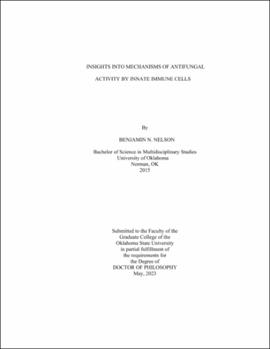| dc.contributor.advisor | Wozniak, Karen L. | |
| dc.contributor.author | Nelson, Benjamin N. | |
| dc.date.accessioned | 2023-08-30T19:45:18Z | |
| dc.date.available | 2023-08-30T19:45:18Z | |
| dc.date.issued | 2023-05 | |
| dc.identifier.uri | https://hdl.handle.net/11244/339030 | |
| dc.description.abstract | Cryptococcus neoformans is an opportunistic fungal pathogen that causes over 180,000 annual deaths in HIV/AIDS patients. Innate phagocytes such as dendritic cells
(DCs) and macrophages are the first cells to interact with the pathogen, with destruction
inside a mature lysosome through degradation with acid hydrolases and reactive
oxygen/nitrogen species. This work investigates the mechanisms of antifungal activity by
innate immune cells. Previous studies have shown that innate immune cells will either
allow for intracellular growth or kill the fungus by recognizing, phagocytosing, and
finally destroying the fungus within a mature lysosome using both oxidative and
nonoxidative mechanisms. We hypothesize that there are certain subsets that allow for
differential interactions of the fungus and that killing by nonoxidative means is made
possible by many different lysosomal proteins. Results showed several lysosomal
proteins affected the growth of C. neoformans. Proteins that killed or inhibited the fungus
did so in a dose-dependent manner. Furthermore, protein concentrations needed for
cryptococcal inhibition were found to be non-cytotoxic to mammalian cells. Results also
showed all macrophage and dendritic cell subsets interacted with the fungus, and both
living and killed morphologies were discernable within the subsets using imaging flow
cytometry. Single-cell RNA-seq identified several different clusters of cells which more
closely related to interactions with C. neoformans and its protective capacity against the
pathogen rather than discrete cellular subsets. Differential gene expression analyses
identified several changes in the innate immune cell as it kills the fungus, including
increases of TNF-α and a switch to fatty acid metabolism by upregulation of FABP4.
Also, increases of TNF-α correlated to cryptococcal interactions. These data show
signaling networks that regulate expression of many different genes—both metabolic and
immune—as certain clusters of cells mount a protective response. This protective
response is facilitated by proteins that have antifungal activity and are well tolerated by
mammalian cells. Future studies will examine these proteins, genes, and networks to
understand the exact mechanism(s) these subsets use to kill C. neoformans in order to
develop immunotherapeutic strategies to combat this deadly disease. | |
| dc.format | application/pdf | |
| dc.language | en_US | |
| dc.rights | Copyright is held by the author who has granted the Oklahoma State University Library the non-exclusive right to share this material in its institutional repository. Contact Digital Library Services at lib-dls@okstate.edu or 405-744-9161 for the permission policy on the use, reproduction or distribution of this material. | |
| dc.title | Insights into mechanisms of antifungal activity by innate immune cells | |
| dc.contributor.committeeMember | Hadwiger, Jeffrey A. | |
| dc.contributor.committeeMember | Lutter, Erika I. | |
| dc.contributor.committeeMember | Cabeen, Matthew T. | |
| dc.contributor.committeeMember | Oomens, Antonius G. P. | |
| osu.filename | Nelson_okstate_0664D_18094.pdf | |
| osu.accesstype | Open Access | |
| dc.type.genre | Dissertation | |
| dc.type.material | Text | |
| dc.subject.keywords | antifungal | |
| dc.subject.keywords | cryptococcus | |
| dc.subject.keywords | dendritic cells | |
| dc.subject.keywords | lysosome | |
| dc.subject.keywords | macrophages | |
| dc.subject.keywords | metabolism | |
| thesis.degree.discipline | Microbiology, Cell and Molecular Biology | |
| thesis.degree.grantor | Oklahoma State University | |
